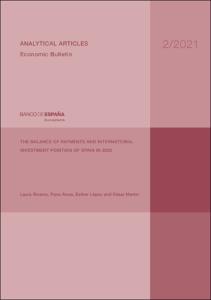Registro completo de metadatos
| Campo DC | Valor |
|---|---|
| dc.contributor.author | Álvarez-Román, Laura |
| dc.contributor.author | Alves, Pana |
| dc.contributor.author | López, Esther |
| dc.contributor.author | Martín Machuca, César |
| dc.coverage.spatial | España |
| dc.date.accessioned | 2021-06-07T19:03:11Z |
| dc.date.available | 2021-06-07T19:03:11Z |
| dc.date.issued | 2021-06-03 |
| dc.identifier.uri | https://repositorio.bde.es/handle/123456789/16782 |
| dc.description | Artículo de revista |
| dc.description.abstract | In 2020, the Spanish economy recorded net lending of 1.1% of GDP, significantly below the previous year’s level of 2.5%. This decline essentially reflects the impact of the health crisis on travel credits, which contracted sharply, owing to the restrictions on international mobility and on activity in accommodation and food and travel services to contain the pandemic. The widening of the secondary income deficit also contributed to the decline in net lending, albeit to a much lesser extent. These developments offset the improvement in the other components, which was particularly notable in the goods and primary income balances. Cross-border financial transactions were strongly influenced by the increase in the volume of Eurosystem asset purchases, as reflected by a large surplus on the financial account of resident sectors, excluding the Banco de España. By contrast, the financial transactions of the Banco de España with the rest of the world showed a large increase in its liabilities. Spain’s negative net international investment position increased to 84.3% of GDP, essentially as a result of the sharp fall in GDP and the decline in the value of external financial assets owing to the appreciation of the euro. Finally, in terms of GDP, the nation’s gross external debt stood at all-time highs (199.4%) owing to the contraction in economic activity and the assumption of new liabilities, in particular by the Banco de España, given the increase in its positions vis-à-vis the Eurosystem as a result of the implementation of the asset purchase programmes. |
| dc.format.extent | 22 p. |
| dc.language.iso | en |
| dc.publisher | Banco de España |
| dc.relation.ispartof | Economic Bulletin / Banco de España, 2/2021 |
| dc.relation.hasversion | Versión en español 123456789/16751 |
| dc.rights | Reconocimiento-NoComercial-CompartirIgual 4.0 Internacional (CC BY-NC-SA 4.0) |
| dc.rights | In Copyright - Non Commercial Use Permitted |
| dc.rights.uri | https://creativecommons.org/licenses/by-nc-sa/4.0/deed.es_ES |
| dc.rights.uri | http://rightsstatements.org/vocab/InC-NC/1.0/ |
| dc.subject | Net lending |
| dc.subject | Current account |
| dc.subject | Financial transactions |
| dc.subject | Foreign direct investment |
| dc.subject | TARGET balances |
| dc.subject | International investment position |
| dc.subject | External debt |
| dc.subject | Economic situation |
| dc.subject | Financial analysis |
| dc.title | The balance of payments and international investment position of Spain in 2020 |
| dc.type | Artículo |
| dc.identifier.bdebib | 000471404 |
| dc.identifier.bdepub | ECBU-2021-2B-art17 |
| dc.subject.bde | Comercio internacional |
| dc.subject.bde | Finanzas internacionales |
| dc.publisher.bde | Madrid : Banco de España, 2021 |
| dc.subject.jel | F10 |
| dc.subject.jel | F21 |
| dc.subject.jel | F30 |
| dc.subject.jel | F32 |
| dc.subject.jel | F34 |
| dc.subject.jel | E50 |












